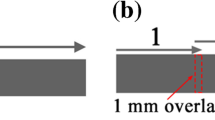Abstract
The Goldak’s double-ellipsoid volumetric heat source model is commonly used for arc welding in numerical simulation. Usually, heat source geometric parameters and arc efficiency need to be calibrated in thermal analysis until a good agreement with experiments is achieved. However, the influence of individual heat source geometric parameters and arc efficiency on welding temperature field, residual stress, and distortion is still unclear. In this study, this influence has been systematically investigated in a thin-plate full-penetration weld by methods of both numerical simulation and experimental method. The predicted and measured results indicate that the location of HAZ boundary and the Δt8/5 time can only be influenced by arc efficiency (significantly) and heat source width (slightly) in thin-plate full-penetration welds. Furthermore, the variation of arc efficiency can significantly affect welding residual stress and distortion, while the reasonable change of heat source geometric parameters has a slight effect. In this study, a calibration procedure of heat input model in FE simulation of thin-plate full-penetration welds is provided.
Similar content being viewed by others
References
Radaj D (1992) Heat effects of welding on temperature field, residual stress and distortion. Springer, Berlin
Ueda Y, Murakawa H, Ma N (2012) Welding deformation and residual stress prevention. Elsevier, Berlin
Pan M (2012) Minimization of welding distortion and buckling. Woodhead Publishing Limited
Mats N, Magnus K (2014) Welding heat input models. In: Encyclopedia of thermal stress. Springer, Netherlands, pp 6567–6572
Sun JM, Liu XZ, Tong YG, Deng DA (2014) A comparative study on welding temperature field, residual stress distribution and deformations induced by laser beam welding and CO2 gas arc welding. Mater Des 63:519–530
Goldak J (2005) Computational welding mechanics. Springer, Science and Business Media
Goldak J, Chaakravarti A, Bibby M (1984) A new finite element model for welding heat sources. Metall Trans B 15B:299–305
Lindgren L (2007) Computational welding mechanics. Woodhead Publishing, Cambridge
Gery D, Long H, Maropoulos P (2005) Effects of welding speed, energy input and heat source distribution on temperature variations in butt joint welding. J Mater Process Technol 167:393–401
Amin S, Sigmund D, Odd M (2012) Determination of welding heat source parameters from actual bead shape. Comput Mater Sci 54:176–182
Yadaiah N, Bag S (2012) Effect of heat source parameters in thermal and mechanical analysis of linear GTA welding process. ISIJ Int 52:2069–2075
Bradac J (2013) Calibration of heat source model in numerical simulation of fusion welding. Machines & Technologies & Materials 11:9–12
Tseng K, Huang J (2013) Arc efficiency assisted finite element model for predicting residual stress of TIG welded sheet. Journal of Computers 8:2182–2189
Joshi S, Hildebrand J, Aloraier A, Rabczuk T (2013) Characterization of material properties and heat source parameters in welding simulation of two overlapping beads on a substrate plate. Comput Mater Sci 69:559–565
Fu G, Gu J, Lourenco M, Estefen (2014) Determination of welding heat source parameters from actual bead shape. Ship and Offshore Structures 10:1–14
Velaga S, Ravisankar A (2017) Finite element based parametric study on the characterization of weld process moving heat source parameters in austenitic stainless steel. Int J Press Vessel Pip 157:63–73
Tafarroj M, Kolahan F (2018) A comparative study on the performance of artificial neural networks and regression models in modeling the heat source model parameters in GTA welding. Fusion Eng Des 131:111–118
Simufact Engineering Company (2016) Theory and user information. Hamburg, Germany
Salerno G, Bennett C, Sun W, Becker A, Palumbo N, Kelleher J, Zhang SY (2018) On the interaction between welding residual stresses: a numerical and experimental investigation. Int J Mech Sci 144:654–667
Bhatti A, Barsoum Z, Murakawa H, Barsoum I (2015) Influence of thermo-mechanical material properties of different steel grades on welding residual stresses and angular distortion. Mater Des 65:878–889
Johnson A, Mehl R (1939) Reaction kinetics in processes of nucleation and growth. Trans Am Inst Min Engrs 135:416
Koistinen D, Marburger R (1959) A general equation prescribing the extent of the austenite-martensite transformation in pure iron-carbon alloys and plain carbon steels. Acta Metall 7:59–60
Chang K, Lee C (2006) Characteristics of high temperature tensile properties and residual stresses in weldments of high strength steels. Mater Trans 47:348–354
Chen B, Young J, Uy B (2006) Behavior of high strength structural steel at elevated temperatures behavior of high strength structural steel. J Struct Eng 132:1948–1954
Loose, T (2008) Einfluß des transienten Schweißvorganges auf Verzug, Eigenspannungen und Stabilitätsverhalten axial gedrückter Kreiszylinderschalen aus Stahl. Dissertation, Karlsruhe Institute of Technology (TH)
Stenbacka N, Choquet I, Hurtig K (2012) Review of arc efficiency values for gas tungsten arc welding. IIW Commission IV-XII-SG212 Intermediate Meeting BAM, Berlin, Germany
Wang JC, Rashed S, Murakawa H (2014) Mechanism investigation of welding induced buckling using inherent deformation method. Thin-Walled Struct 80:103–119
Deng DA, Zhou YJ, Bi T, Liu XZ (2013) Experimental and numerical investigations of welding distortion induced by CO2 gas arc welding in thin-plate bead-on joints. Mater Des 52:720–729
Acknowledgements
Special thanks to the China Scholarship Council (CSC) for its financial support.
Author information
Authors and Affiliations
Corresponding author
Additional information
Highlights
1. The effect of individual heat source geometric parameters and arc efficiency on welding temperature field is clarified.
2. The influence mechanism of heat source geometric parameters and arc efficiency on welding residual stress and distortion is discussed.
3. A calibration procedure of heat input model in FE simulation of thin-plate full-penetration welds is provided.
Rights and permissions
About this article
Cite this article
Sun, J., Klassen, J., Nitschke-Pagel, T. et al. Effects of heat source geometric parameters and arc efficiency on welding temperature field, residual stress, and distortion in thin-plate full-penetration welds. Int J Adv Manuf Technol 99, 497–515 (2018). https://doi.org/10.1007/s00170-018-2516-6
Received:
Accepted:
Published:
Issue Date:
DOI: https://doi.org/10.1007/s00170-018-2516-6




